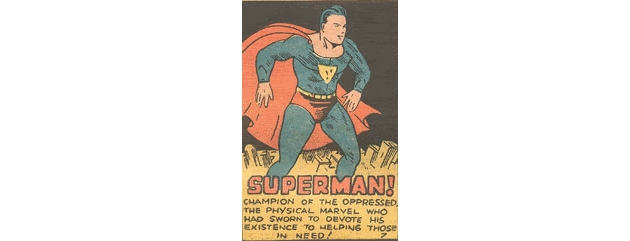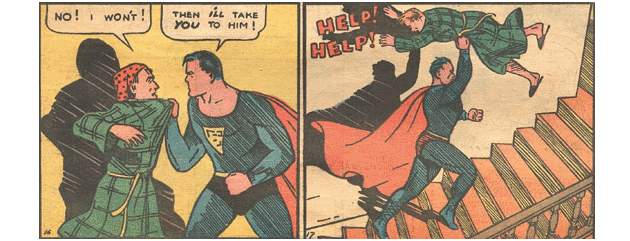Superman Comic Books
Truth, Justice, and the American Way: Using Action Comics #1 as a Historic Source
By Darren R. Reid

Few fictional characters can claim the iconic status of Jerry Siegel's and Joel Schuster's 1938 creation, Superman. Able to leap tall buildings in a single bound, to outrun speeding bullets, and possessing near supernatural strength, he was - and remains - one of the most easily identifiable parts of the twentieth century pop-culture canon. But for all that, Siegel and Schuster's creation was very much a product of its time, an icon not of the ages but of an America struggling to overcome the Great Depression. In modern times the Man of Steel is depicted as Earth's greatest champion, protecting the planet from the greatest threats his writers can imagine but in his first appearance in Action Comics #1 quite a different character was presented to readers. Not only did he lack many of his most iconic powers - he was unable to fly, for instance - but his attitude, outlook, and concerns differed from the modern Man of Steel in a number of interesting ways. Considering how ingrained the modern Superman has become to our modern pop-culture, these differences help to shine a light on the world that originally gave birth - and eagerly consumed - this archetypical superhero. In that sense, at least, Superman's debut appearance serves as a curious sort of historical source. There are certainly better places to look in order to gain an insight into American attitudes and views on the eve of World War II but Action Comics #1 nevertheless serves as a great window into how those values were packaged to the soon-to-be baby boomer generation.
In later incarnations, Superman would come to be defined by three guiding principles - Truth, Justice, and the American Way. These three tenets have proven contentious in recent years with the 2006 movie Superman Returns coming under fire for daring to modify this apparently untouchable mantra ("Truth, justice, and all that stuff") but the controversy surrounding this change overshadowed something far more important. In Action Comics #1 neither truth nor the American Way made any overt appearance. Instead, the Man of Steel was defined by an equally powerful, though now more obscure, idea - Superman was "Champion of the Oppressed" - something which did not necessarily line-up with the more conformist belief in the "American way" which would later come to define the character. Perhaps the most interesting thing about this initial presentation of Superman's guiding principle is that women were the first "oppressed" group to seriously come under his protection.

"Champion of the Oppressed"
Broadly speaking, Superman's appearance in Action Comics #1 can be divided into three sections. In the first part of the story, he confronts the governor of his unnamed home state concerning the impending execution of Evelyn Curry, a woman falsely imprisoned and sentenced to death for murder. Aside from convincing the governor to pardon the falsely convicted Curry, Superman demonstrates the truth of his name - not only does he display his physical prowess with only the slightest of justifications, his hyper-masculine attitude sees him bullying his way past the governor's butler through the use of intimidation and repeated shows of his physical capacity, a timely reminder to modern readers that the "man" in Superman was not misplaced. Siegel and Schuster did not, after all, create a Superperson and the importance of Superman's masculinity is repeatedly emphasised throughout his first appearance. In this first section Superman smashes through no less than two doors (one of which is made of steel), deflects a bullet, and repeatedly bullies the governor's baffled butler. Regardless, the innocent Evelyn Curry's life is at stake and with only fifteen minutes until her execution these strong arm tactics appear to be perfectly justified within the book's pages. In the twenty-first century the best parallel - at least with regards to this introductory episode - would probably be 24's Jack Bauer…though that's a blog for another day.

A little intimidation and mild physical coercion never hurt anyone, did it?
Strictly speaking, the rescue of Ms. Curry falls short of showing Superman's early status as a defender of women - the real murderer, whom he delivers to the governor, is also a woman. In the second part of the story, however, this aspect of his character is really underlined when Superman intervenes in a "wife-beating." Arriving just as an abusive husband raises a belt over his stricken wife, the Man of Steel violently hurtles the perpetrator against a wall whilst shouting "You're not fighting a woman, now!" No, he is fighting an idealised vision of purely expressed masculinity. Put simply, real men - or super men - do not hit women. More to the point, super men use their physical strength to defend those who cannot defend themselves, a broad category repeatedly characterised by women throughout the issue. Indeed, the third and final part of this issue sees Superman saving yet another female victim; throughout the entirety of Action Comics #1 the Man of Steel rescues no men whatsoever.Unlike his previous two rescues, the final victim in Action Comics #1 complicates the situation not least because she is, in many ways, a far cry from the previously undeveloped female characters Superman has thus far saved. In the first part of the issue, Evelyn Curry is seen only briefly, on her knees clutching at a priest's robe, her only line being "Thank God! I told you I was innocent." The second victim is given even less character in her one-panel appearance, lying unconscious and mute before her abusive husband. In the final section of the story readers are introduced to one of the staples of the Superman mythology - Lois Lane - the strong female lead. Almost immediately Lois is depicted as totally in-control, unwilling to bend to the desires of the men around her unless those desires happen to coincide with her own. On a date with Clark Kent, this attitude is expressed explicitly when she refuses the advances of another man, the bluntly named Butch, even going so far as to slap him across the face when he insists "You'll dance with me and like it!" She then shows no small amount of disdain for Clark's "weakling" persona after he failed to stand up for her during this incident, sweeping aside any ambiguity when tells him: "You asked me earlier in the evening why I avoid you. I'll tell you why now: because you're a spineless, unbearable coward! [sic]" In Superman's first story Lois is a strong, empowered character - but she nevertheless continues to desire strength and courage in a potential partner. She desires strength of character, conviction and, considering the context, the physical might to back-up these traits.
Even if, at first glance, it appears that Lois and Clark represent an inversion of the male/female dynamic already expressed in this comic, it seems hard to imagine Lois's desires being expressed by any of the males who inhabit this universe. Lois may eschew the passive victimhood of the book's other female characters but she continues to value traditionally masculine traits already established as core parts of Superman's character. Nor is she, for all her strength of character, free from the looming spectre of victimhood. Shortly after dressing Clark down for his masculine ineptitude, Lois is kidnapped by Butch and his goons. It seems telling that from this point onwards Lois is given no more dialogue of consequence - during the ordeal she tells her attackers to "Let me go!" but is otherwise silent until she tries to convince her unnamed editor that she really did see Superman. For his part, Lois's editor replies condescendingly "Are you sure it wasn't pink elephants you saw?" In every way Lois's depiction following her kidnapping (and rescue) strips away much of her strength. Predictably it fell to Superman to rescue her. Lois is certainly the strongest female character in this issue, but she cannot escape the stereotypes strongly associated with her gender. Empowered and in control, she nevertheless looks for strength and protection from the men in her life.
In many ways, Action Comics #1 tells us a lot about how gender roles were perceived immediately prior to World War II. Superman - the idealised vision of masculinity - defends those who cannot defend themselves, a group which is, at least in this debut story, characterised by women. Even Lois, established early on as head-strong and independent, is partially defined by the dominant stereotypes which infuse this work. That being said, there is another angle from which to approach Siegel and Schuster's depiction of women. True, stereotypes abound but the women in this story are strongly associated not necessarily with weakness but oppression, a distinction which appears to recognise the unfairness of their status at this time. At the very least, this association - particularly in the context of the domestic violence depicted in this story - suggests that women deserved protection from men who might otherwise use them for their own selfish, destructive ends. Few of the male characters in this issue, Superman aside, are represented in positive terms with many instead depicted as thoroughly villainous in nature. Although superheroes tend to be associated with super villains, in this story it appears that men, by default, fulfil the corrupted, oppressive role that these larger-than-life characters would eventually come to embody and exaggerate. In stark contrast, the women in this tale tend to be victims not necessarily of the stereotypical weaknesses this story references but of the men who seek to dominate their lives and affairs.
Of course, we should be careful about reading too much into this story; it is, in many ways, the very definition of pulp fiction. And yet, the character of Superman introduced here would quickly become a cultural icon, suggesting that there was something about his presentation that resonated with his early readers. Set against a backdrop of negative stereotypes - for men and women alike - Action Comics #1 created a blunt depiction of the idealised man which tells us much about attitudes towards both genders at this time. Women suffered in comparison to Siegel and Schuster's creation but, more to the point, they were depicted as suffering the most when those who claimed superiority over them failed to act as the "champions" they deserved. Perhaps the most important take-away from Action Comics #1 is not its reliance upon negative stereotypes but rather the manner in which it subtly reflected challenges to them. Women in this story tend to be victims of oppression but in one particular scene Siegel and Schuster reflect their changing role in American society. Fed-up with Butch's bullish advances, Lois slaps him across the face. Looking on, Clark, who must protect his secret identity through a mask of passivity and cowardice, reacts against the blow - "Lois – - Don't!" whilst under his breath whispering "Good for you, Lois!" On the surface, Action Comics #1 presented its readership with a strong male role model who stood out against a backdrop of dastardly men and victimised women. In Lois, however, the pair created a female role model who, in spite of continued stereotyping, reflected at least some degree of the tangible empowerment possible for American women on the eve of the Second World War.

Some whispered support for female empowerment
